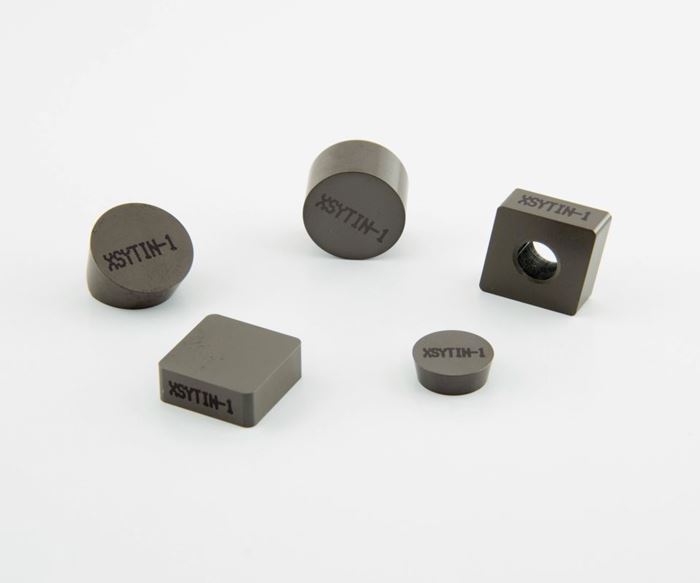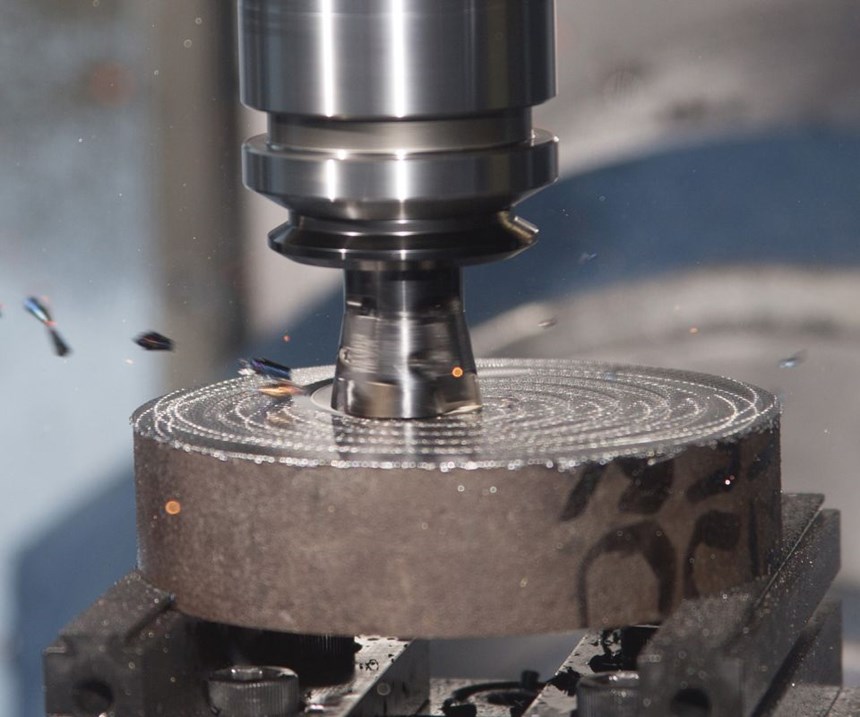Ceramic Insert Grade Has Broad Range of Applications
When Greenleaf’s staff of researchers started exploring what they could do with a new manufacturing method to induce internal crystal growth within a silicon-nitride-based ceramic for forming ceramic composite cutting tool inserts, they "got pretty excited," as the story goes. They even named the new grade Xsytin—as in “excitin’.”
Share








.png;maxWidth=45)
DMG MORI - Cincinnati
Featured Content
View More
ECi Software Solutions, Inc.
Featured Content
View MoreWhen Greenleaf’s staff of researchers started exploring what they could do with a new manufacturing method to induce in-situ (internal) crystal growth within a silicon-nitride-based ceramic for forming ceramic composite cutting tool inserts, they "got pretty excited," as the story goes. This was because the process enabled them to produce a highly wear-resistant, yet very strong cutting tool material. They recognized that this development might fundamentally alter the range of applications for ceramic cutting tools. Jim Wyant, an application engineer at Greenleaf, summed it up this way: “With almost twice the strength of whisker-reinforced ceramics, this new ceramic composite runs at feed rates typically used for carbide inserts while the cutting speeds match those common with ceramic inserts.” The result, he says, is a cutting tool material capable of two to three times the productivity of other ceramic composite tools, in both turning and milling operations.
Generically, Greenleaf calls this material a phase-toughened ceramic, because the proprietary mixture of silicon nitride goes through a series of phases during the manufacturing process that toughens the ceramic. Because “exciting” was the description most often used when the research team was exploring that material’s capability in lab tests, the brand-name Xsytin (excitin’) was coined. The first inserts formulated and released commercially have been designated Xsytin-1 in anticipation that additional grades will be introduced in the future. The company reports that the current grade has a 174,000-psi modulus of rupture, although other formulations are likely to yield further improvement in material properties.
Greenleaf expects this new grade to reshape applications for ceramic composite cutting tools in two broad areas. One area is boosting productivity for machining difficult alloys. For instance, feed rates for phase-toughened ceramics can be greatly increased where ceramics are being applied successfully in continuous cuts of heat-resistant super alloys (HRSAs) with a high-nickel content such as Inconel, Waspaloy and other workpiece materials favored in aerospace.
In fact, increased feed rates are a must for this grade because a high level of flank wear and notching will occur, leading to premature tool failure. More important, machining HRSAs requires heat for the plasticization, or softening, necessary for removal with a ceramic cutting tool. However, it is also necessary to get that heat out of the machining zone efficiently to protect the workpiece material from thermal damage. Increasing the feed rate while maintaining the depth of cut appropriate for ceramic inserts results in a larger chip that can carry off more heat rapidly. Effective heat removal also retards chemical wear of the phase-toughened ceramic insert. Mr. Wyant reports that the Greenleaf lab quickly discovered that the new grade showed substantial improvements in tool life “the harder we pushed it.”
The company offers this comparison to illustrate the importance and benefit of higher feed rates. For turning Inconel 718 with a round, uncoated, whisker-reinforced ceramic insert that has a 0.5-inch (12.7-mm) inscribed circle, a cutting speed of 800 sfm (244 m/min.), a feed of 0.008 ipr (0.20 mm/rev.) and a depth of cut of 0.080 inch (2.03 mm) is recommended. This results in a metal-removal rate of 6 in.3/min. (100.6 cm3/min.). To switch to a comparable phase-toughened ceramic insert, a slight speed reduction is typically necessary, but the feed rate can be greatly increased. Current in-production applications indicate that 700 to 750 sfm (213 to 229 m/min.), 0.014 to 0.016 ipr (0.36 to 0.41 mm/rev.) and 0.080 to 0.120 inch (2.03 to 3.05 mm) depth of cut creates the “sweet spot” for machining this material. The result is a metal-removal rate from 9.4 to 17.3 in.3/min. (154.2 cm3/min. to 283.5 cm3/min.) when conditions are ideal.
Another significant thrust for phase-toughened ceramic inserts is in applications that formerly ruled out ceramics. This is a benefit of the ceramic material’s ability to operate across a wide cutting speed range. For example, where ceramics could not be used because available rpm on a machine was limited, phase-toughened ceramics work well. The company says that cutting speeds can be as low as 450 sfm (137 ipm) and can be combined with a slightly lighter feed rate of 0.008 to 0.010 ipr (0.20 to 0.25 mm/rev.) at the same depth of cut used for traditional ceramics. This approach is recommended for bulky aerospace parts manufactured on large machines that often have limited spindle speeds or on equipment that would present a safety hazard if it were to utilize high spindle speeds with large parts.
Likewise, the phase-toughened ceramic grade has the ability to retain strength in demanding, high-force, interrupted cuts. The grade successfully machines parts with forging or casting scale, as well as highly abrasive material. Compacted graphite iron in engine blocks and pump houses is reportedly milled successfully at approximately 1,800 sfm with the new grade (compared to carbide at speeds of 350 to 550 sfm). Similarly, nodular iron formerly turned with carbide at 200 sfm and 0.010 ipr is turned with Xsytin-1 at 400 sfm and 0.020 ipr. Similar results are said to be obtainable in ductile iron, steel alloys and stainless steel.
Greenleaf has been providing the new grade to select customers for more than a year. The results of these diverse applications has helped the company refine its speed and feed recommendations for the wide variety of workpiece materials for which it is suitable. Xystin-1 is currently available in several insert styles, including round, button, square and special geometries.
Related Content
Finding the Right Tools for a Turning Shop
Xcelicut is a startup shop that has grown thanks to the right machines, cutting tools, grants and other resources.
Read MoreThe Impact of Cutting Teeth Spacing on Machining Stability
Many cutter designs are available, and variable teeth spacing (or variable pitch) cutters can be used to influence milling stability. Let’s discuss why teeth spacing affects stability.
Read MoreToolpath Improves Chip Management for Swiss-Type Lathes
This simple change to a Swiss-type turning machine’s toolpath can dramatically improve its ability to manage chips.
Read MoreThe Future of High Feed Milling in Modern Manufacturing
Achieve higher metal removal rates and enhanced predictability with ISCAR’s advanced high-feed milling tools — optimized for today’s competitive global market.
Read MoreRead Next
Registration Now Open for the Precision Machining Technology Show (PMTS) 2025
The precision machining industry’s premier event returns to Cleveland, OH, April 1-3.
Read More5 Rules of Thumb for Buying CNC Machine Tools
Use these tips to carefully plan your machine tool purchases and to avoid regretting your decision later.
Read MoreSetting Up the Building Blocks for a Digital Factory
Woodward Inc. spent over a year developing an API to connect machines to its digital factory. Caron Engineering’s MiConnect has cut most of this process while also granting the shop greater access to machine information.
Read More












































